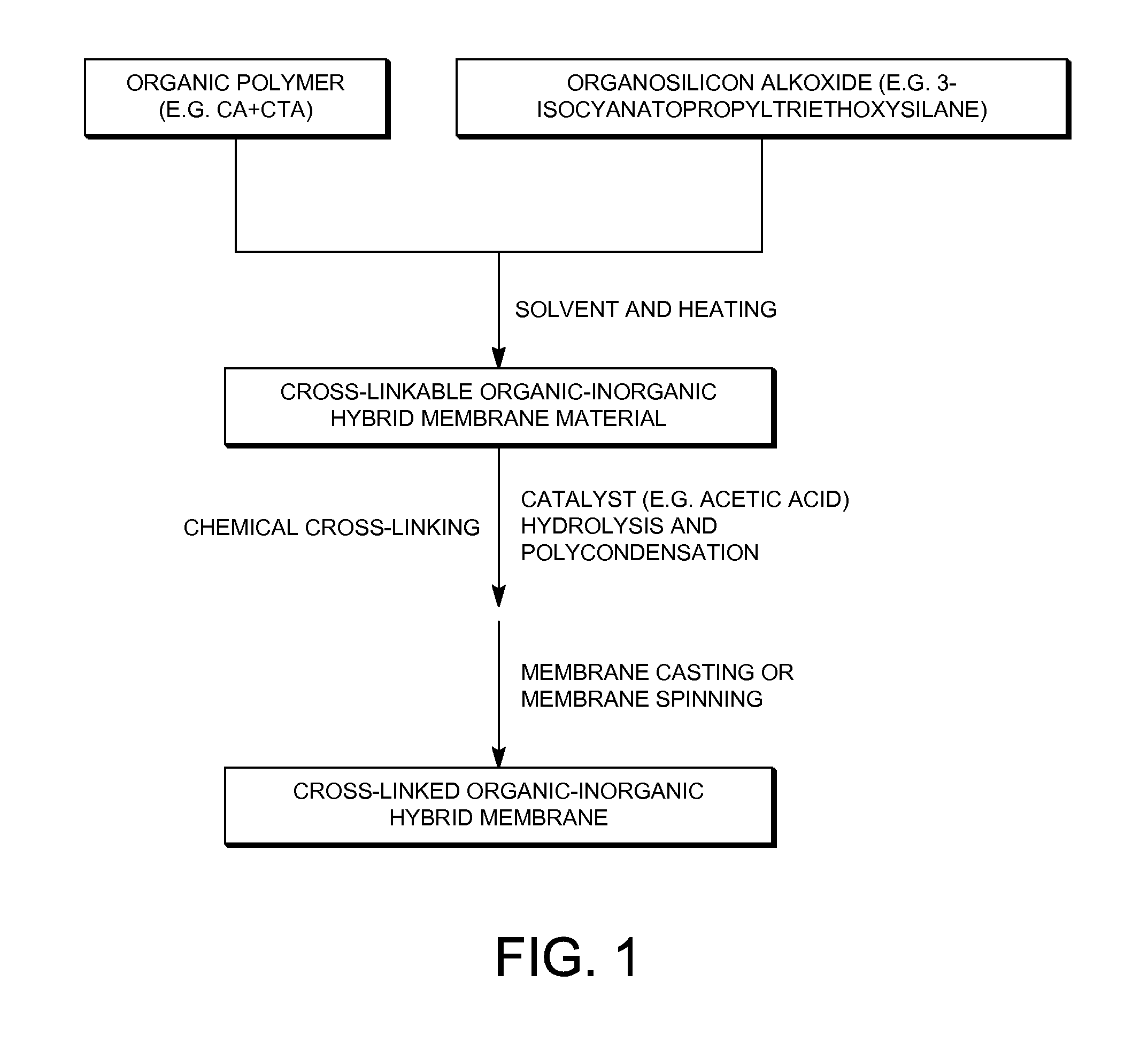Plasticization resistant membranes
a technology of plasticization resistance and membranes, applied in the field of plasticization resistance, can solve the problems of inorganic membranes with technical limitations, brittleness and lack of surface integrity, and achieve the effects of high plasticization resistance chemically, easy control of cross-linking degree, and improved chemical and mechanical stability
- Summary
- Abstract
- Description
- Claims
- Application Information
AI Technical Summary
Benefits of technology
Problems solved by technology
Method used
Image
Examples
example 1
Preparation of Cross-Linked Cellulose Acetate-Polyurethanepropylsilsesquioxane Organic-Inorganic Hybrid Membrane (Abbreviated Herein as CA-Urethane-Si-2-1 Membrane)
1) a Cross-Linkable Cellulose Acetate-Urethanepropyltriethoxysilane Organic-Inorganic Membrane Material was Synthesized According to the Procedure as Shown in FIG. 3
[0064]Five grams (18.9 mmol) of cellulose acetate polymer (“EASTMAN” Cellulose Acetate (CA-398-3) from Eastman Chemical Company, Kingsport, Tenn.) was dissolved in 119.5 grams of tetrahydrofuran or 1,4-dioxane solvent. 1.29 grams (5.2 mmol) of 3-isocyanatopropyltriethoxysilane (from Gelest, Inc, Morrisville, Pa.) was added to the CA solution. After the solution was heated at 60° C. for 48 hours, a solution containing 5.0 wt-% of the cross-linkable cellulose acetate-urethanepropyltriethoxysilane organic-inorganic membrane material was obtained. About half of the hydroxyl groups on the cellulose acetate polymer had been substituted by triethoxysilyl groups throu...
example 2
Characterization of CA-Urethane-Si-2-1 Membrane
[0066]The successful formation of covalently interpolymer-chain-connected organic-inorganic hybrid networks in the cross-linked CA-Urethane-Si-2-1 membrane was confirmed by FTIR spectra. The formation of urethane linkages between cellulose acetate polymer and the inorganic polysilsesquioxane segments in the cross-linked cellulose acetate-polyurethanepropylsilsesquioxane membrane was confirmed by FTIR spectra. FIG. 5 shows the FTIR spectra of pure cellulose acetate polymer membrane and the cross-linked CA-Urethane-Si-2-1 membrane. As shown in FIG. 5, the cross-linked CA-Urethane-Si-2-1 membrane showed the appearance of a vibration band at about 1568 cm−1 corresponding to a NH—CO group, indicating the formation of urethane linkages.
example 3
Preparation of Cross-Linked Cellulose Acetate-Polyurethanepropylsilsesquioxane Organic-Inorganic Hybrid Membrane (Abbreviated Herein as CA-Urethane-Si-1-1 Membrane)
1) Synthesis of Cross-Linkable CA-Urethanepropyltriethoxysilane Organic-Inorganic Membrane Material
[0067]5.0 Grams (18.9 mmol) of cellulose acetate polymer (“EASTMAN” Cellulose Acetate (CA-398-3) from Eastman Chemical Company, Kingsport, Tenn.) was dissolved in 144.0 grams of THF or 1,4-dioxane solvent. 2.58 grams (10.4 mmol) of 3-isocyanatopropyltriethoxysilane (from Gelest, Inc, Morrisville, Pa.) was added to the CA solution. After the solution was heated at 60° C. for 48 hours, a solution containing 5.0 wt-% of the cross-linkable CA-urethanepropyltriethoxysilane organic-inorganic membrane material was obtained. All the hydroxyl groups on the CA polymer had been substituted by triethoxysilyl groups through urethane linkages in this cross-linkable cellulose acetate-urethanepropyltriethoxysilane organic-inorganic membrane...
PUM
| Property | Measurement | Unit |
|---|---|---|
| temperature | aaaaa | aaaaa |
| distances | aaaaa | aaaaa |
| molar ratios | aaaaa | aaaaa |
Abstract
Description
Claims
Application Information
 Login to View More
Login to View More - R&D
- Intellectual Property
- Life Sciences
- Materials
- Tech Scout
- Unparalleled Data Quality
- Higher Quality Content
- 60% Fewer Hallucinations
Browse by: Latest US Patents, China's latest patents, Technical Efficacy Thesaurus, Application Domain, Technology Topic, Popular Technical Reports.
© 2025 PatSnap. All rights reserved.Legal|Privacy policy|Modern Slavery Act Transparency Statement|Sitemap|About US| Contact US: help@patsnap.com



